Dibner Scholars Past Scholars
Dibner Library Resident Scholars 2006
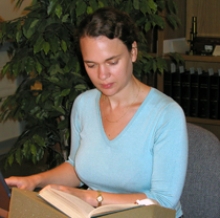 DR. REBEKAH FRANCES HIGGITT is currently an Academic Visitor/Teaching Assistant in the Centre for the History of Science, Technology, and Medicine at Imperial College London. She received her Ph.D. in 2004 from the Centre with her thesis, "The Apple of Their Eye? Biographies of Isaac Newton, 1820-70." She hopes to expand on her thesis with her project at the Dibner Library, "Writing and Using the History of Science in 19th-Century Britain." As she notes in her proposal, "the middle decades of the 19th century are particularly important [for publication of histories of science] because of the evolving role of the man of science within wider society, the nascent professionalisation, specialisation and secularisation of science, and the development of a new expertise in the field of history of science." She plans to survey the historical literature in the Dibner Library to tease out the many aspects of this literary area in order gain some understanding into the concept of men of science as historians of science. This may help her understand the importance of such factors as the idealization of science, the intended audiences, the meaning of the term "scientist," the portrayal of scientific disciplines, the social and religious commitments of the authors, and their methodological and stylistic similarities in how scientists produced histories of science in the 19th century. At the Dibner Library, Dr. Higgitt plans to examine the many histories of science we have in addition to our many encyclopedias and biographies of scientists from the 1800s.
DR. REBEKAH FRANCES HIGGITT is currently an Academic Visitor/Teaching Assistant in the Centre for the History of Science, Technology, and Medicine at Imperial College London. She received her Ph.D. in 2004 from the Centre with her thesis, "The Apple of Their Eye? Biographies of Isaac Newton, 1820-70." She hopes to expand on her thesis with her project at the Dibner Library, "Writing and Using the History of Science in 19th-Century Britain." As she notes in her proposal, "the middle decades of the 19th century are particularly important [for publication of histories of science] because of the evolving role of the man of science within wider society, the nascent professionalisation, specialisation and secularisation of science, and the development of a new expertise in the field of history of science." She plans to survey the historical literature in the Dibner Library to tease out the many aspects of this literary area in order gain some understanding into the concept of men of science as historians of science. This may help her understand the importance of such factors as the idealization of science, the intended audiences, the meaning of the term "scientist," the portrayal of scientific disciplines, the social and religious commitments of the authors, and their methodological and stylistic similarities in how scientists produced histories of science in the 19th century. At the Dibner Library, Dr. Higgitt plans to examine the many histories of science we have in addition to our many encyclopedias and biographies of scientists from the 1800s.
DR. EDWARD JURKOWITZ is Assistant Professor of History at the University of Illinois at Chicago. He has a good publication record and his book, Liberal Pursuits: Hermann von Helmholtz, Ernst Mach and the framing of physics and the human mind has been reviewed and accepted by Kluwer Academic Publishers. He received his Ph.D. in History of Science from the University of Toronto in 1995 with his dissertation, "Interpreting Superconductivity: The History of Quantum Theory and the Theory of Superconductivity and Superfluidity, 1933-1957." His project at the Dibner Library, "Physiological Psychology, the Signaling Model, and Inner Relativity (1860-1905)," is an outgrowth of his research on his upcoming book. This new project is based on the notion that the basic post-Einsteinian concepts of relativity of signals to a particular observer were explicitly examined or foreshadowed by a subgroup of physically trained physiological psychologists such as Hermann Helmholtz, Hermann Aubert, Rudolf Koenig, Arthur Koenig, Wilhelm Wundt, Adolf Fick, Gustav Fechner, and Ernst Mach, among others. These researchers studied how humans received sound and light signals and how these were transmitted through the body, in much the same way that physical scientists and electrical engineers studied the transmission of signals in telegraphic, optical, and acoustical systems. In addition, there was a close connection between the researchers in these two different areas, and Dr. Jurkowitz hopes to be able to better illuminate how this physiological research informed the development of physical relativity. At the Dibner Library he will use the monographs and articles written by the researchers mentioned above as well as most of our extensive collection of 19th- and very early 20th-century works on physiological optics, physical acoustics, and telegraphy. He would also be able to study many of the instruments housed in the National Museum of American History's collections.
 DR. CLIFFORD SCHEXNAYDER is Eminent Scholar Emeritus at the Del E. Webb School of Construction at Arizona State University. He has an extensive career as a civil engineer and a long list of publications, including numerous works on the history of civil engineering. The committee was particularly impressed with his ability to author general-interest books on civil engineering and its history. He received his Ph.D. in Construction Engineering and Management from Purdue University in 1980 and has spent most of his career at Louisiana Tech, the U.S. Army Engineering School, and Arizona State University. He is described as the world's leading authority on construction equipment and he has authored the most widely used text in the field. His research project at the Dibner Library, "The Hoosac Tunnel-Birthplace of Modern Tunneling," will utilize his expertise in civil engineering and its history. The Hoosac Tunnel (25,000 feet long) in Massachusetts was the longest tunnel in North America from its completion in 1873 until 1916 when it was surpassed. It took twenty-two years to complete and workers used virtually every kind of device available to bore through the rock, many developed just for this tunnel, and nitroglycerin was first used to blast the Hoosac Tunnel. It is an excellent project to use to trace the historical development of tunneling practice. Dr. Schexnayder will use the primary materials in the Dibner Library relating to the building of the Hoosac Tunnel as well as other contemporary works that describe tunneling practice in Europe.
DR. CLIFFORD SCHEXNAYDER is Eminent Scholar Emeritus at the Del E. Webb School of Construction at Arizona State University. He has an extensive career as a civil engineer and a long list of publications, including numerous works on the history of civil engineering. The committee was particularly impressed with his ability to author general-interest books on civil engineering and its history. He received his Ph.D. in Construction Engineering and Management from Purdue University in 1980 and has spent most of his career at Louisiana Tech, the U.S. Army Engineering School, and Arizona State University. He is described as the world's leading authority on construction equipment and he has authored the most widely used text in the field. His research project at the Dibner Library, "The Hoosac Tunnel-Birthplace of Modern Tunneling," will utilize his expertise in civil engineering and its history. The Hoosac Tunnel (25,000 feet long) in Massachusetts was the longest tunnel in North America from its completion in 1873 until 1916 when it was surpassed. It took twenty-two years to complete and workers used virtually every kind of device available to bore through the rock, many developed just for this tunnel, and nitroglycerin was first used to blast the Hoosac Tunnel. It is an excellent project to use to trace the historical development of tunneling practice. Dr. Schexnayder will use the primary materials in the Dibner Library relating to the building of the Hoosac Tunnel as well as other contemporary works that describe tunneling practice in Europe.
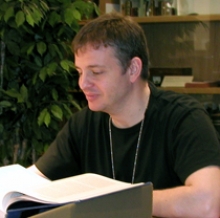 DR. ARISTOTELIS TYMPAS is Lecturer on the History of Technology at the Department of History and Philosophy of Science at the University of Athens, Greece. He received his Ph.D. in 2001 from the History, Technology, and Society Department at the Georgia Institute of Technology with his dissertation, "The Computor and the Analyst: Computing and Power, 1880s-1960s." His research project at the Dibner Library, "On the Industrial-Information Revolution Relationship: Towards a History of Steam Engine Calculations," is an extension of his dissertation work on the importance of computing techniques during the heyday of electrification (1880-1930). He hopes to extend his argument back earlier than 1880 by studying the importance of the calculating process in constructing and employing steam engines. Devices such as planimeters and other early forms of slide rules were used for steam engine calculations and Dr. Tympas plans to study the development, availability, and use of these devices to further inform our understanding of the importance of computing and instruments in the history of steam engines in particular and technology in general. He plans to use the Dibner Library's many works on steam engines as well as the numerous general encyclopedia articles and works about instruments.
DR. ARISTOTELIS TYMPAS is Lecturer on the History of Technology at the Department of History and Philosophy of Science at the University of Athens, Greece. He received his Ph.D. in 2001 from the History, Technology, and Society Department at the Georgia Institute of Technology with his dissertation, "The Computor and the Analyst: Computing and Power, 1880s-1960s." His research project at the Dibner Library, "On the Industrial-Information Revolution Relationship: Towards a History of Steam Engine Calculations," is an extension of his dissertation work on the importance of computing techniques during the heyday of electrification (1880-1930). He hopes to extend his argument back earlier than 1880 by studying the importance of the calculating process in constructing and employing steam engines. Devices such as planimeters and other early forms of slide rules were used for steam engine calculations and Dr. Tympas plans to study the development, availability, and use of these devices to further inform our understanding of the importance of computing and instruments in the history of steam engines in particular and technology in general. He plans to use the Dibner Library's many works on steam engines as well as the numerous general encyclopedia articles and works about instruments.
Dibner Library Resident Scholars 2005
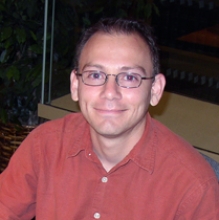 DANIEL G. CAMPOS is a Ph.D. candidate in the Department of Philosophy of Pennsylvania State University. For his dissertation, “The Discovery and Growth of Mathematical Probability Theory: A Case Study in the Logic of Mathematical Inquiry,” he has been studying the method of inquiry of the early probability theorists and accounting for the origins of their concepts. He has been concentrating on the “emergent” period of probability theory, going up to the 1713 publication of Jacob Bernoulli’s landmark work,Ars conjectandi. For his Dibner Library project, “The Development of Mathematical Probability Theory, 1713-1812,” Mr. Campos will examine what he calls the “consolidation” period of probability theory in which calculus is applied to the theory, from Bernoulli’s work up to the appearance of Laplace’s Théorie analytique des probabilités in 1812. Besides the works mentioned above, Mr. Campos will examine other works by Arnauld, De Moivre, Legendre, and Gauss, as well as the many articles by Leibniz in our newly-acquired Acta eruditorum.
DANIEL G. CAMPOS is a Ph.D. candidate in the Department of Philosophy of Pennsylvania State University. For his dissertation, “The Discovery and Growth of Mathematical Probability Theory: A Case Study in the Logic of Mathematical Inquiry,” he has been studying the method of inquiry of the early probability theorists and accounting for the origins of their concepts. He has been concentrating on the “emergent” period of probability theory, going up to the 1713 publication of Jacob Bernoulli’s landmark work,Ars conjectandi. For his Dibner Library project, “The Development of Mathematical Probability Theory, 1713-1812,” Mr. Campos will examine what he calls the “consolidation” period of probability theory in which calculus is applied to the theory, from Bernoulli’s work up to the appearance of Laplace’s Théorie analytique des probabilités in 1812. Besides the works mentioned above, Mr. Campos will examine other works by Arnauld, De Moivre, Legendre, and Gauss, as well as the many articles by Leibniz in our newly-acquired Acta eruditorum.
 LESLEY CORMACK is Professor and Chair of the Department of History and Classics of the University of Alberta, Canada. As part of her continuing research, Dr. Cormack’s project is “The Molyneux Globes: Instruments, Mathematical Practitioners, and the Scientific Revolution.” She has been using the Dibner Library’s collection to investigate the complex interconnections between mathematicians, geographers, and globe and instrument-makers, particularly in London. She has been using a number of pertinent works at the Dibner Library, including mathematical, geographical, and navigational texts by Varenius, Robert Recorde, Edward Wright, Peter Apian, Rembert Dodoens, Nicolas Bion, Simon Stevin, and Thomas Blundeville, among others.
LESLEY CORMACK is Professor and Chair of the Department of History and Classics of the University of Alberta, Canada. As part of her continuing research, Dr. Cormack’s project is “The Molyneux Globes: Instruments, Mathematical Practitioners, and the Scientific Revolution.” She has been using the Dibner Library’s collection to investigate the complex interconnections between mathematicians, geographers, and globe and instrument-makers, particularly in London. She has been using a number of pertinent works at the Dibner Library, including mathematical, geographical, and navigational texts by Varenius, Robert Recorde, Edward Wright, Peter Apian, Rembert Dodoens, Nicolas Bion, Simon Stevin, and Thomas Blundeville, among others.
 TAYRA LANUZA-NAVARRO is a Ph.D. candidate at the Institute of the History of Science and Documentation “López Piñero” of the Faculty of Medicine of the University of Valencia, Spain. Her dissertation is “Astrology, Science, and Society in Hapsburg Spain” and she expects to receive her degree later this year. At the Dibner Library Ms. Lanuza-Navarro is extending her research with her project, “Astrology and Religion in 17th-Century Spain.” At the Dibner Library she will concentrate on works that will allow her to delve deeper in the question of astrology and religion, studying the works of ancient, medieval, and modern authors that were often cited by Spanish astrologers in the ongoing polemic between astrology and religious writers. She will examine the works in the Dibner Library of Cecco d’Ascoli, Claudius Coelestinus, Pico della Mirandola, Pierre d’Ailly, Pietro d’Abano, and Guido Bonati that are cited by Spanish authors in their defense of astrology. She will also look at the works of the Islamic astrologers Massalah, Abenragel, Al Biruni, Alcabitius, and Albumassar that were cited hundreds of times by Spanish Christian authors.
TAYRA LANUZA-NAVARRO is a Ph.D. candidate at the Institute of the History of Science and Documentation “López Piñero” of the Faculty of Medicine of the University of Valencia, Spain. Her dissertation is “Astrology, Science, and Society in Hapsburg Spain” and she expects to receive her degree later this year. At the Dibner Library Ms. Lanuza-Navarro is extending her research with her project, “Astrology and Religion in 17th-Century Spain.” At the Dibner Library she will concentrate on works that will allow her to delve deeper in the question of astrology and religion, studying the works of ancient, medieval, and modern authors that were often cited by Spanish astrologers in the ongoing polemic between astrology and religious writers. She will examine the works in the Dibner Library of Cecco d’Ascoli, Claudius Coelestinus, Pico della Mirandola, Pierre d’Ailly, Pietro d’Abano, and Guido Bonati that are cited by Spanish authors in their defense of astrology. She will also look at the works of the Islamic astrologers Massalah, Abenragel, Al Biruni, Alcabitius, and Albumassar that were cited hundreds of times by Spanish Christian authors.
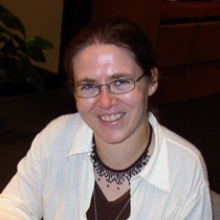 AN SMETS is currently a Scientific Collaborator in the Unit of Medieval History in the Faculty of Philosophy and Letters at the Catholic University of Louvain, Belgium. She is studying the “vernacularization” of medieval scientific works and her research project for her residency at the Dibner Library is “The Liber Aggregationis: A Case Study of Translation of Medieval Scientific Treatises.” The Liber aggregationis of Albertus Magnus was a very popular text that covered a variety of topics: astrology, zoology, astronomy, medicine, and physiology. More than 100 manuscript copies survive and it was translated into many vernacular languages, but no critical edition has ever been prepared for this work. For her project here, Dr. Smets will concentrate on the Dibner Library’s manuscript of an Italian translation of Liber aggregations for use in a critical edition. In this she will be aided by comparing the manuscript with two printed Latin texts of the same work as well as a modern English translation.
AN SMETS is currently a Scientific Collaborator in the Unit of Medieval History in the Faculty of Philosophy and Letters at the Catholic University of Louvain, Belgium. She is studying the “vernacularization” of medieval scientific works and her research project for her residency at the Dibner Library is “The Liber Aggregationis: A Case Study of Translation of Medieval Scientific Treatises.” The Liber aggregationis of Albertus Magnus was a very popular text that covered a variety of topics: astrology, zoology, astronomy, medicine, and physiology. More than 100 manuscript copies survive and it was translated into many vernacular languages, but no critical edition has ever been prepared for this work. For her project here, Dr. Smets will concentrate on the Dibner Library’s manuscript of an Italian translation of Liber aggregations for use in a critical edition. In this she will be aided by comparing the manuscript with two printed Latin texts of the same work as well as a modern English translation.
 IAN G. STEWART is a Senior Fellow in the Foundation Year Program and Adjunct Faculty in the History of Science and Technology Program of the University of King’s College in Halifax, Nova Scotia, Canada. His research project at the Dibner Library will be “William Gilbert’s ‘New Philosophy Concerning Our Sublunary World’ (1651): A Critical Edition and Translation.” Dr. Stewart has been collaborating with Stephen Pumfrey (University of Lancaster, UK) on a critical edition and English translation of Gilbert’s De mundo nostro sublunari and it is expected to be published in 2005-6. At the Dibner Library Dr. Stewart will examine a number of works by Aristotle, Tycho, Cardano, Galen, Cornelius Gemma, Paracelsus, Pliny, Scaliger, Telesio, and others that should help in making clearer Gilbert’s sources of inspiration.
IAN G. STEWART is a Senior Fellow in the Foundation Year Program and Adjunct Faculty in the History of Science and Technology Program of the University of King’s College in Halifax, Nova Scotia, Canada. His research project at the Dibner Library will be “William Gilbert’s ‘New Philosophy Concerning Our Sublunary World’ (1651): A Critical Edition and Translation.” Dr. Stewart has been collaborating with Stephen Pumfrey (University of Lancaster, UK) on a critical edition and English translation of Gilbert’s De mundo nostro sublunari and it is expected to be published in 2005-6. At the Dibner Library Dr. Stewart will examine a number of works by Aristotle, Tycho, Cardano, Galen, Cornelius Gemma, Paracelsus, Pliny, Scaliger, Telesio, and others that should help in making clearer Gilbert’s sources of inspiration.
Dibner Library Resident Scholars 2004
 MR. DANIELE COZZOLI is a Ph.D. candidate at the Department of Philosophical and Epistemological Studies of the University of Rome "La Sapienza." For his dissertation, titled "Descartes' concept of proof," he has been working closely with the faculty of the noted Centre Koyré of the École des Hautes Études en Sciences in Paris. For his BA thesis on revolutions in mathematics, he spent three months at King's College London. His proposed research at the Dibner Library is "Optics and Scientific Method in Britain from Hobbes to Newton." He is particularly interested in looking at the role the study of optics played in the development of the scientific method. His dissertation on Descartes looked at the beginning of the debate on optical theories between Descartes and Fermat and their use in the development of the Cartesian scientific method. Mr. Cozzoli proposes to extend the study he began in his dissertation by moving from the French theoretical debates on optics to the British experimental research on optics. He will be spending six months with us using the rich resources in the field of optics present in the Dibner Library's collections, including works by Kepler, Gassendi, Hobbes, Molyneux, and Newton.
MR. DANIELE COZZOLI is a Ph.D. candidate at the Department of Philosophical and Epistemological Studies of the University of Rome "La Sapienza." For his dissertation, titled "Descartes' concept of proof," he has been working closely with the faculty of the noted Centre Koyré of the École des Hautes Études en Sciences in Paris. For his BA thesis on revolutions in mathematics, he spent three months at King's College London. His proposed research at the Dibner Library is "Optics and Scientific Method in Britain from Hobbes to Newton." He is particularly interested in looking at the role the study of optics played in the development of the scientific method. His dissertation on Descartes looked at the beginning of the debate on optical theories between Descartes and Fermat and their use in the development of the Cartesian scientific method. Mr. Cozzoli proposes to extend the study he began in his dissertation by moving from the French theoretical debates on optics to the British experimental research on optics. He will be spending six months with us using the rich resources in the field of optics present in the Dibner Library's collections, including works by Kepler, Gassendi, Hobbes, Molyneux, and Newton.
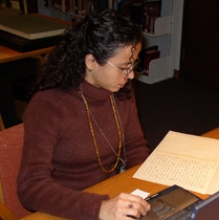 DR. CIBELLE CELESTINO SILVA is currently a postdoctoral fellow at the Group of History and Theory of Science of the Gleb Wataghin Physics Institute of the State University of Campinas, Brazil. She has published a number of papers with her advisor, Dr. Roberto de Andrade Martins, and is a promising young scholar in the history of physics. Her dissertation, produced at the State University of Campinas in 2002, was "From Force to Tensor: Evolution of the Physical Conception and Mathematical Representation of the Electromagnetic Field." At the Dibner Library she proposes to extend her studies back to the eighteenth century in her project, "Unraveling the Hidden Electrical Fluids: The Debate Between Nollet, Dutour, and Franklin." She is particularly interested in studying the details of the debate between Nollet and Franklin on whether electricity was the product of the action of one or two fluids. During her four months in residence, she will be studying the printed works of Beccaria, Dutour, Franklin, Nollet, Priestley, William Watson, and Benjamin Wilson, and the voluminous correspondence between Dutour and Nollet, consisting of some 100 letters on electrical experimentation written between 1742 and 1770.
DR. CIBELLE CELESTINO SILVA is currently a postdoctoral fellow at the Group of History and Theory of Science of the Gleb Wataghin Physics Institute of the State University of Campinas, Brazil. She has published a number of papers with her advisor, Dr. Roberto de Andrade Martins, and is a promising young scholar in the history of physics. Her dissertation, produced at the State University of Campinas in 2002, was "From Force to Tensor: Evolution of the Physical Conception and Mathematical Representation of the Electromagnetic Field." At the Dibner Library she proposes to extend her studies back to the eighteenth century in her project, "Unraveling the Hidden Electrical Fluids: The Debate Between Nollet, Dutour, and Franklin." She is particularly interested in studying the details of the debate between Nollet and Franklin on whether electricity was the product of the action of one or two fluids. During her four months in residence, she will be studying the printed works of Beccaria, Dutour, Franklin, Nollet, Priestley, William Watson, and Benjamin Wilson, and the voluminous correspondence between Dutour and Nollet, consisting of some 100 letters on electrical experimentation written between 1742 and 1770.
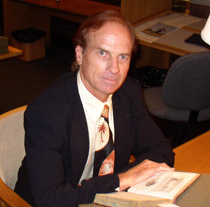 MR. MICHAEL E. CHAUVIN is currently the director of the Hawaiian Skies program, an astronomy education program aimed at promoting and teaching the richness of Hawaiianbased astronomy to school children and tourists. He received an M.Phil. from the Department of the History and Philosophy of Science at Cambridge University in 1988 with his thesis, "Issues in 20th-century Cosmology: Closing Pandora's Box." He has published several works on the history of astronomy with an emphasis on Hawaiian-based astronomy. One of his works-in-progress is a book, Before Mauna Kea: Astronomy in Hawaii from Ancient to Modern Times, and his research project at the Dibner Library will form a part of this larger work. With his residency project, "Before Mauna Kea: Astronomy in Hawaii in the 19th-century," he will work on a period of Hawaiian astronomy that has not received much attention until now. Part of his two months in residence will be spent in looking at the works that were instrumental in astronomy education on the islands, such as the works of Denison Olmsted and Nathaniel Bowditch. Additional time may be spent with the Library's collection of the correspondence of G. B. Airy and other British astronomical works on fleshing out the details of the 1874 British expedition to Hawaii to view the transit of Venus, a subject on which Mr. Chauvin has written extensively.
MR. MICHAEL E. CHAUVIN is currently the director of the Hawaiian Skies program, an astronomy education program aimed at promoting and teaching the richness of Hawaiianbased astronomy to school children and tourists. He received an M.Phil. from the Department of the History and Philosophy of Science at Cambridge University in 1988 with his thesis, "Issues in 20th-century Cosmology: Closing Pandora's Box." He has published several works on the history of astronomy with an emphasis on Hawaiian-based astronomy. One of his works-in-progress is a book, Before Mauna Kea: Astronomy in Hawaii from Ancient to Modern Times, and his research project at the Dibner Library will form a part of this larger work. With his residency project, "Before Mauna Kea: Astronomy in Hawaii in the 19th-century," he will work on a period of Hawaiian astronomy that has not received much attention until now. Part of his two months in residence will be spent in looking at the works that were instrumental in astronomy education on the islands, such as the works of Denison Olmsted and Nathaniel Bowditch. Additional time may be spent with the Library's collection of the correspondence of G. B. Airy and other British astronomical works on fleshing out the details of the 1874 British expedition to Hawaii to view the transit of Venus, a subject on which Mr. Chauvin has written extensively.
Dibner Library Resident Scholars 2003
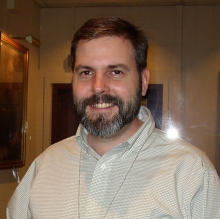 DR. JAMES DAY is Associate Professor of Physics in the Division of Natural Sciences at Transylvania University in Lexington, Kentucky as well as Curator of the Moosnick Science Museum at Transylvania, a large collection of scientific and medical nineteenth-century teaching apparatus. Dr. Day will use the Dibner Library collections to research the museum’s scientific instruments. Instrument descriptions in the Dibner Library by firms such as Bland & Long, Brown & Pierce, E. M. Clarke, Daniel Davis, Jr., W. and S. Jones, and Pixii will provide important information on the instruments themselves.
DR. JAMES DAY is Associate Professor of Physics in the Division of Natural Sciences at Transylvania University in Lexington, Kentucky as well as Curator of the Moosnick Science Museum at Transylvania, a large collection of scientific and medical nineteenth-century teaching apparatus. Dr. Day will use the Dibner Library collections to research the museum’s scientific instruments. Instrument descriptions in the Dibner Library by firms such as Bland & Long, Brown & Pierce, E. M. Clarke, Daniel Davis, Jr., W. and S. Jones, and Pixii will provide important information on the instruments themselves.
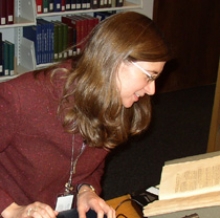 DR. HELEN HATTAB is a Lilly Fellow and Visiting Assistant Professor of Philosophy at Wabash College in Crawfordsville, Indiana. The title of her research program at the Dibner Library is "Causes, Laws, and Mechanics: Connections Between Renaissance Mechanics and the Mechanical Philosophy." This research is part of her book-length project that will place Descartes' modern view of causation and scientific explanation in its intellectual context and reassess its historical and philosophical significance. She will be using many of the Library's sixteenth- and seventeenth-century works on mechanics.
DR. HELEN HATTAB is a Lilly Fellow and Visiting Assistant Professor of Philosophy at Wabash College in Crawfordsville, Indiana. The title of her research program at the Dibner Library is "Causes, Laws, and Mechanics: Connections Between Renaissance Mechanics and the Mechanical Philosophy." This research is part of her book-length project that will place Descartes' modern view of causation and scientific explanation in its intellectual context and reassess its historical and philosophical significance. She will be using many of the Library's sixteenth- and seventeenth-century works on mechanics.
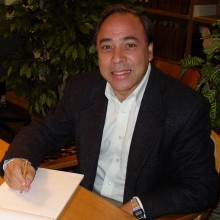 DR. GILDO MAGALHÃES DOS SANTOS is Professor of History of Science and Technology in the History Department of the University of São Paulo, Brazil. His research project at the Dibner Library will be "Electromagnetism and Natural Philosophy in the Early Nineteenth-Century." The marvelous collection of works on electricity will provide a fertile ground for Dr. Santos's research and he will be looking at a number of titles and manuscripts by Ampère, Arago, Fresnel, Gauss, Kirchhoff, Ørsted, and many others.
DR. GILDO MAGALHÃES DOS SANTOS is Professor of History of Science and Technology in the History Department of the University of São Paulo, Brazil. His research project at the Dibner Library will be "Electromagnetism and Natural Philosophy in the Early Nineteenth-Century." The marvelous collection of works on electricity will provide a fertile ground for Dr. Santos's research and he will be looking at a number of titles and manuscripts by Ampère, Arago, Fresnel, Gauss, Kirchhoff, Ørsted, and many others.
 DR. MICHAEL SCHIFFER is Professor of Anthropology and Director of the Laboratory of Traditional Technology at the University of Arizona. At the Dibner Library he will be working on a research project titled "Electrical Science from Volta to Edison." Dr. Schiffer intends to use works in the collection by authors such as Ampère, Davy, Ørsted, Faraday, Arago, Biot, de la Rive, and Maxwell to look at the changing application of electrical technology after the advent of Volta's battery and Ørsted's discovery of electromagnetism.
DR. MICHAEL SCHIFFER is Professor of Anthropology and Director of the Laboratory of Traditional Technology at the University of Arizona. At the Dibner Library he will be working on a research project titled "Electrical Science from Volta to Edison." Dr. Schiffer intends to use works in the collection by authors such as Ampère, Davy, Ørsted, Faraday, Arago, Biot, de la Rive, and Maxwell to look at the changing application of electrical technology after the advent of Volta's battery and Ørsted's discovery of electromagnetism.
Dibner Library Resident Scholars 2002
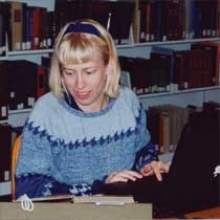 AMY K. ACKERBERG-HASTINGS is an independent scholar who received her Ph.D. in History of Technology and Science in 2000 from Iowa State University. Dr. Ackerberg-Hastings proposes to conduct research on a history of American geometry education from 1750 to 1950. The project is an expansion of her dissertation, "Analysis and Synthesis in American College Geometry Teaching, 1790-1840." She intends to explore "the arenas in which students learned geometry…, the content these students were supposed to master, the methods teachers used to impart content to students, and the reasons why geometry was considered a central component of liberal education." Historians have long overlooked American mathematics education, and the only large-scale study was Florian Cajori's 1890 work, The teaching and history of mathematics in the United States. Dr. Ackerberg-Hastings intends to bring Cajori's account up to date with regard to geometry education and to place history of mathematics education in its proper context with history of science, social history, and intellectual and cultural history. One aspect of her project is to look at the European background to and influence over American geometry teaching. The Dibner Library's many editions of Euclid's Elements, English translations of European geometry textbooks, European works in practical geometry, European manuscript notebooks, and nineteenth-century alternative presentations of Euclidean geometry will provide much information to guide this part of her research.
AMY K. ACKERBERG-HASTINGS is an independent scholar who received her Ph.D. in History of Technology and Science in 2000 from Iowa State University. Dr. Ackerberg-Hastings proposes to conduct research on a history of American geometry education from 1750 to 1950. The project is an expansion of her dissertation, "Analysis and Synthesis in American College Geometry Teaching, 1790-1840." She intends to explore "the arenas in which students learned geometry…, the content these students were supposed to master, the methods teachers used to impart content to students, and the reasons why geometry was considered a central component of liberal education." Historians have long overlooked American mathematics education, and the only large-scale study was Florian Cajori's 1890 work, The teaching and history of mathematics in the United States. Dr. Ackerberg-Hastings intends to bring Cajori's account up to date with regard to geometry education and to place history of mathematics education in its proper context with history of science, social history, and intellectual and cultural history. One aspect of her project is to look at the European background to and influence over American geometry teaching. The Dibner Library's many editions of Euclid's Elements, English translations of European geometry textbooks, European works in practical geometry, European manuscript notebooks, and nineteenth-century alternative presentations of Euclidean geometry will provide much information to guide this part of her research.
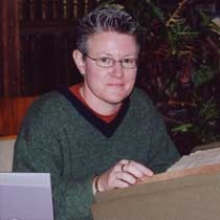 JEN E. BOYLE is a Ph.D. candidate in English with Critical Theory and Feminist Emphases at the University of California, Irvine. Her doctoral dissertation is titled "The Anamorphic Imagination and the Empirical Body: Perspective and the Embodiment of Space and Text in Restoration and Early Eighteenth-Century Science." Her work concentrates on geometrical and mathematical perspective theories and uses them to look more closely at artistic theories and symbolism, experimental space and technology, and scientific and literary narratives. The perspective manuals, which became more numerous from 1650 to 1700, function as a forum to explore the convergence of textual narration and sensory perception as well as that of "practical" crafts and abstract mathematical and scientific thought. Ms. Boyle's work at the Dibner Library will extend her study of English perspective manuals into the eighteenth century and enable her to study the exchange of theories and technologies between England and France in that period, particularly in the works of Isaac Newton and G. W. von Leibniz. In addition, the Dibner Library's holdings include a number of English translations by Edmund Stone of European works on perspective, a collection surpassed only by the holdings at the University of Wales.
JEN E. BOYLE is a Ph.D. candidate in English with Critical Theory and Feminist Emphases at the University of California, Irvine. Her doctoral dissertation is titled "The Anamorphic Imagination and the Empirical Body: Perspective and the Embodiment of Space and Text in Restoration and Early Eighteenth-Century Science." Her work concentrates on geometrical and mathematical perspective theories and uses them to look more closely at artistic theories and symbolism, experimental space and technology, and scientific and literary narratives. The perspective manuals, which became more numerous from 1650 to 1700, function as a forum to explore the convergence of textual narration and sensory perception as well as that of "practical" crafts and abstract mathematical and scientific thought. Ms. Boyle's work at the Dibner Library will extend her study of English perspective manuals into the eighteenth century and enable her to study the exchange of theories and technologies between England and France in that period, particularly in the works of Isaac Newton and G. W. von Leibniz. In addition, the Dibner Library's holdings include a number of English translations by Edmund Stone of European works on perspective, a collection surpassed only by the holdings at the University of Wales.
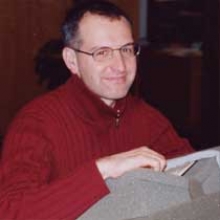 GUIDO GIGLIONI is a Ph.D. candidate in the Department of the History of Science, Medicine, and Technology at The Johns Hopkins University in Baltimore. Mr. Giglioni is already a well-published scholar having written a book (in Italian, published in 2000) on the scientist J. B. van Helmont. His Hopkins dissertation is an analysis of the work and life of Francis Glisson (1598-1677), English anatomist, physician, and philosopher. Glisson, with all his connections in the Royal College of Physicians and the University of Cambridge, was a very active representative of the scientific life of the time. Mr. Giglioni's study of Glisson looks at his work in anatomy in terms of the view of the nature of life and living matter. At the Dibner Library, he will carry out an investigation of the philosophical views on motion, life, and perception in the works of the authors that influenced Glisson. These authors include Francis Bacon, William Gilbert, Tommaso Campanella, Jean Baptiste van Helmont, and William Harvey, all of whose works are well represented in the Dibner Library's collection.
GUIDO GIGLIONI is a Ph.D. candidate in the Department of the History of Science, Medicine, and Technology at The Johns Hopkins University in Baltimore. Mr. Giglioni is already a well-published scholar having written a book (in Italian, published in 2000) on the scientist J. B. van Helmont. His Hopkins dissertation is an analysis of the work and life of Francis Glisson (1598-1677), English anatomist, physician, and philosopher. Glisson, with all his connections in the Royal College of Physicians and the University of Cambridge, was a very active representative of the scientific life of the time. Mr. Giglioni's study of Glisson looks at his work in anatomy in terms of the view of the nature of life and living matter. At the Dibner Library, he will carry out an investigation of the philosophical views on motion, life, and perception in the works of the authors that influenced Glisson. These authors include Francis Bacon, William Gilbert, Tommaso Campanella, Jean Baptiste van Helmont, and William Harvey, all of whose works are well represented in the Dibner Library's collection.
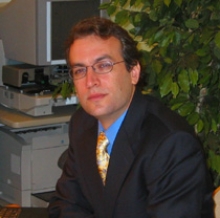 NEIL FRANKLIN SAFIER is a Ph.D. candidate in the History Department at The Johns Hopkins University in Baltimore. He is also currently a fellow at the Ecole des Hautes Etudes en Sciences Sociales in Paris. His dissertation is on Charles-Marie de La Condamine (1701-1774) and his scientific expeditions to the Andes and the Amazon. He is in the final stages of his dissertation research to understand how scientific arguments and instruments transformed the representation of the Amazon from the broad-brush descriptions in early atlases to the detailed, precisely engraved maps of the eighteenth century. At the Dibner Library Mr. Safier plans to study the transformations in the astronomical and geographical sciences that occurred in the early eighteenth century. A number of the Dibner Library's works go into detail about the observational procedures used to create cartographic representations in the years leading up to La Condamine's South American expeditions. These works include numerous titles relating to geography and dialling, astronomical tables, the use of scientific instruments, and the rich collection of geographical and astronomical manuscripts.
NEIL FRANKLIN SAFIER is a Ph.D. candidate in the History Department at The Johns Hopkins University in Baltimore. He is also currently a fellow at the Ecole des Hautes Etudes en Sciences Sociales in Paris. His dissertation is on Charles-Marie de La Condamine (1701-1774) and his scientific expeditions to the Andes and the Amazon. He is in the final stages of his dissertation research to understand how scientific arguments and instruments transformed the representation of the Amazon from the broad-brush descriptions in early atlases to the detailed, precisely engraved maps of the eighteenth century. At the Dibner Library Mr. Safier plans to study the transformations in the astronomical and geographical sciences that occurred in the early eighteenth century. A number of the Dibner Library's works go into detail about the observational procedures used to create cartographic representations in the years leading up to La Condamine's South American expeditions. These works include numerous titles relating to geography and dialling, astronomical tables, the use of scientific instruments, and the rich collection of geographical and astronomical manuscripts.
Dibner Library Resident Scholars 2001
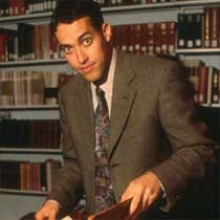 ALBERTO MARTINEZ is a doctoral candidate at the University of Minnesota. His field of study is the history of science and technology with a minor in the philosophy of science. Mr. Martinez proposes to conduct research on the modern science of motion. He states that since antiquity, many scientists regarded statics as the fundamental physical science. Since the early 1800s, scientists increasingly became convinced that the science of motion, "kinematics," was actually the fundamental physical science. Mr. Martinez proposes to analyze works on mechanics, textbooks, and treatises on how kinematics displaced statics as the fundamental branch of physics, and other materials to support his plan. He has a strong interest in the relationship between physics and mathematics, particularly in cases where mathematical rules are established on the basis of empirical knowledge.
ALBERTO MARTINEZ is a doctoral candidate at the University of Minnesota. His field of study is the history of science and technology with a minor in the philosophy of science. Mr. Martinez proposes to conduct research on the modern science of motion. He states that since antiquity, many scientists regarded statics as the fundamental physical science. Since the early 1800s, scientists increasingly became convinced that the science of motion, "kinematics," was actually the fundamental physical science. Mr. Martinez proposes to analyze works on mechanics, textbooks, and treatises on how kinematics displaced statics as the fundamental branch of physics, and other materials to support his plan. He has a strong interest in the relationship between physics and mathematics, particularly in cases where mathematical rules are established on the basis of empirical knowledge.
 JILL CASID is a post-doctoral fellow at the Center for 17th and 18th Century Studies, UCLA. She took her Ph.D. from Harvard University in Art History. For her Dibner Library residency, she proposes to study the magic lantern. Titled "Necromancy of Empire: The Magic Lantern and Technologies of Projection, 1650-1850," her research proposal is an attempt to study "the importance of understanding technologies as not simply instruments but as discursive and social devices including the medium of text and image in print." Her book-length project argues that the magic lantern and the technologies of projection it represented between 1650 and 1850 marks a crucial period of formation and transition in the history of the production of the European self as a rational, thinking subject.
JILL CASID is a post-doctoral fellow at the Center for 17th and 18th Century Studies, UCLA. She took her Ph.D. from Harvard University in Art History. For her Dibner Library residency, she proposes to study the magic lantern. Titled "Necromancy of Empire: The Magic Lantern and Technologies of Projection, 1650-1850," her research proposal is an attempt to study "the importance of understanding technologies as not simply instruments but as discursive and social devices including the medium of text and image in print." Her book-length project argues that the magic lantern and the technologies of projection it represented between 1650 and 1850 marks a crucial period of formation and transition in the history of the production of the European self as a rational, thinking subject.
RICHARD CUNNINGHAM is a lecturer in the Department of English at Penn State University. His Ph.D. in English was recently granted by Penn State University. Dr. Cunningham proposes to study "Image and Text in the Education of English Mariners." In his proposal, he states that the earliest navigational texts in English had to help educate, for the technical needs of the empire, a readership comprised of artisans, tradesmen, and craftsmen. He believes that many of these texts were for the benefit of the men who left the shores of England to explore the world and capture its riches for the King or Queen. An example he cites shows a text that was re-issued with the original dedication replaced by one to "The industrious seamen and mariners of England." How did these men (who were not likely to be literate in the view of some) learn from printed texts how to pilot and chart coastal waters and to navigate the open ocean?
BERTRUM MACDONALD is the director of the School of Library and Information Studies at Dalhousie University. He has his Ph.D. in Library and Information Science. Dr. MacDonald proposes to study "Rhetoric and Reality: Was Science Borderless in the Victorian Era?" There was a view in the mid-19th Century that science was stateless, but was it? Did the scientific enterprise that grew up in the late-Victorian period in North America really ignore the boundary between Canada and the United States? Can it be said that a kind of annexation did occur? The short answer is "no" but the story is more complex and Dr. MacDonald proposes to pursue research to answer this more fully.
Dibner Library Resident Scholars 2000
 VICTORIA ERHART is a candidate for a Ph.D. from The Catholic University of America. Ms. Erhart proposes an interesting project to discern and investigate the tension between science and religion in the thought and writings of Isaac Newton. Her work is part of a larger project to investigate the tension of science and religion in both the pre-modern and modern scientific era. Ms. Erhart's project will have two components. The first, translating Newton's work on Athanasius of Alexandria, including the extensive Latin references to other patristic writers and texts, will also entail an examination of Newton's understanding of Athanasius's writings with texts by Athanasius himself. The second part will be a study of those scientific works and experiments mentioned by Newton in the Athanasius text, in order to reconstruct the process whereby Newton came to the conclusion that the emerging science of mechanics could not be reconciled with the prevailing notion of Trinitarian orthodoxy. She will make use of a significant number of books and manuscripts in the Dibner Library.
VICTORIA ERHART is a candidate for a Ph.D. from The Catholic University of America. Ms. Erhart proposes an interesting project to discern and investigate the tension between science and religion in the thought and writings of Isaac Newton. Her work is part of a larger project to investigate the tension of science and religion in both the pre-modern and modern scientific era. Ms. Erhart's project will have two components. The first, translating Newton's work on Athanasius of Alexandria, including the extensive Latin references to other patristic writers and texts, will also entail an examination of Newton's understanding of Athanasius's writings with texts by Athanasius himself. The second part will be a study of those scientific works and experiments mentioned by Newton in the Athanasius text, in order to reconstruct the process whereby Newton came to the conclusion that the emerging science of mechanics could not be reconciled with the prevailing notion of Trinitarian orthodoxy. She will make use of a significant number of books and manuscripts in the Dibner Library.
Dibner Library Resident Scholars 1999
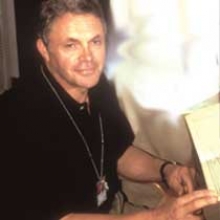 JOHN RENNIE SHORT is a professor of Geography at Syracuse University. He has a Ph. D. and master's degree in geography, both awarded in Scotland. Dr. Short is a prolific scholar, producing a number of books and articles and winning a number of awards for this work. Dr. Short has proposed a project entitled "From Cosmology to Geography" for his time at the Dibner Library. He states that the history of geography is a fascinating subject that means literally "writing about the earth." He wants to conduct research in the Dibner Library to illustrate his argument that older, pre-modern geographies encompassed a wider arc. He wants to go back as far as Claudius Ptolemy in the second century to look at his work and go forward, following the evolution of the study of geography. The Dibner Library has a number of the seminal works by Arabic authors that translate Ptolemy's ideas. As we know, the classical knowledge kept alive in the Arabic world partly fuelled the European Renaissance and such works as Libellus Isagogicus laid the basis for the Renaissance understanding of the world. Further, Dr. Short wants to examine the works of early European cosmographers that are contained in abundance in the Dibner Library.
JOHN RENNIE SHORT is a professor of Geography at Syracuse University. He has a Ph. D. and master's degree in geography, both awarded in Scotland. Dr. Short is a prolific scholar, producing a number of books and articles and winning a number of awards for this work. Dr. Short has proposed a project entitled "From Cosmology to Geography" for his time at the Dibner Library. He states that the history of geography is a fascinating subject that means literally "writing about the earth." He wants to conduct research in the Dibner Library to illustrate his argument that older, pre-modern geographies encompassed a wider arc. He wants to go back as far as Claudius Ptolemy in the second century to look at his work and go forward, following the evolution of the study of geography. The Dibner Library has a number of the seminal works by Arabic authors that translate Ptolemy's ideas. As we know, the classical knowledge kept alive in the Arabic world partly fuelled the European Renaissance and such works as Libellus Isagogicus laid the basis for the Renaissance understanding of the world. Further, Dr. Short wants to examine the works of early European cosmographers that are contained in abundance in the Dibner Library.
GREGORY A. WICKLIFF is an associate professor of English at the University of North Carolina, Charlotte. He has a Master's and a Ph.D. in American literature. His resume lists numerous awards, articles, and lectures. Dr. Wickliff proposes to study the photographic rhetoric of nineteenth-century scientific and technical texts during his Dibner Library residency. Dr. Wickliff outlines the evolution of the practice of including photographs within published texts, beginning with salt-print photographs tipped into works in the 1850s. His research at the Dibner Library will continue his work writing a technical, cultural, and rhetorical history of published photographs based upon images selected from a review of photographically illustrated scientific and technical texts published between 1840 and 1900. In his view, the published photograph has been considered a descent toward mere representation, realism, or naturalism, or a decoration appended to a primarily textual rhetoric.
 CAROLYN DE LA PENA is a Ph.D. candidate in American Studies. She already has a master's degree in American Studies. Ms. De La Pena has been awarded numerous grants and fellowships as she conducted her research over the years and has a number of articles, lectures, and papers to her credit. Ms. De La Pena's project: "Powering the Modern Body: Theories of Energy transfer in American Medicine, Science, and Technology, 1880-1930" will make good use of materials in both the Dibner Library and in the American History Museum Branch Library. Her work focuses on the use of electricity and other technologies as they were used to create more energy in the body. In the 1880s, Americans understood human energy to be finite, that the body never did two things well at once. The discovery of such energy forces as electricity, radium, and industrial machinery, suggested that energy could surpass human limitations. Ms. De La Pena will study the idea that Americans in these years saw no fast barrier between energy produced inside the body and energy produced outside the body, that by adding energy from outside, the body's total energy capacity would be increased.
CAROLYN DE LA PENA is a Ph.D. candidate in American Studies. She already has a master's degree in American Studies. Ms. De La Pena has been awarded numerous grants and fellowships as she conducted her research over the years and has a number of articles, lectures, and papers to her credit. Ms. De La Pena's project: "Powering the Modern Body: Theories of Energy transfer in American Medicine, Science, and Technology, 1880-1930" will make good use of materials in both the Dibner Library and in the American History Museum Branch Library. Her work focuses on the use of electricity and other technologies as they were used to create more energy in the body. In the 1880s, Americans understood human energy to be finite, that the body never did two things well at once. The discovery of such energy forces as electricity, radium, and industrial machinery, suggested that energy could surpass human limitations. Ms. De La Pena will study the idea that Americans in these years saw no fast barrier between energy produced inside the body and energy produced outside the body, that by adding energy from outside, the body's total energy capacity would be increased.
Dibner Library Resident Scholars 1998
SARAH LOWENGARD is a doctoral candidate in history at the State University of New York, Stony Brook. Ms. Lowengard completed a master's degree in history also at Stony Brook and a bachelor's degree in history at Washington University. Her proposed topic for her Dibner Library Residency is "Color Practices, Color Theories, and the Creation of Color in Objects, 1700-1850." This continues work on her dissertation on the same topic. Her plan is to examine the relationship of eighteenth-century techniques of color production and theories prevalent in contemporary chemistry and physics about the nature of color. Ms. Lowengard plans to research the history of the search for new colors and new techniques to produce them.
SHANNON ALLEN BROWN is a doctoral student in history at Merrill College, UC Santa Cruz. He has completed a Master of Arts degree in history at the UC Santa Cruz and a bachelor's degree, also in history, at California Polytechnic University at San Luis Obispo. The Dibner Library Residency will allow him to continue his dissertation research in American military electrification. In fact, the title of his proposed project is "Conquering Time and Space: The Electrification of the United States Army, 1880-1920." A central theme of Mr. Brown's project is to look into the evolution of army policy with respect to electricity between 1880 and 1920 and how electrification contributed to administrative centralization of the U.S. Army in the twentieth century. The Dibner Library's collection of texts on the development of electrical technology and electrical science will be used to trace the evolution of thought on the military applications of electricity.
HARILAOS KITSIKOPOULOS is an adjunct assistant professor of economics at the New York Institute of Technology where he teaches courses on labor economics, macro and micro principles, and basic economics. His proposed topic for his Dibner Library Residency is entitled "Technical Diffusion and British Economic Growth." Dr. Kitsikopoulos will examine the notion that rather than starting in the 1770's as previously understood, modern industrial growth began in the 1840's more as an evolutionary process after the effects of the invention of the steam engine and the railroad were felt. This conclusion has been arrived at by recent recalculations of gross domestic product rates for Great Britain. He participated in a NEH-sponsored seminar organized in Munich to examine these issues in 1995.
Dibner Library Resident Scholars 1997
ANNE MARIE PETROV is a doctoral candidate at the University of Paris in history of science. Ms. Petrov received a DEA (Diploma of Advanced Studies) and Masters degree in history of English science from the University of Paris, an MA in physics from SUNY Stonybrook, and a BA in physics from George Washington University. Her research project is titled, "Geometry, Measure of Intellectual Change: The Case of Isaac Barrow." She is focusing on Barrow as part of her larger interest in the practice of geometry and its wider applications outside the scientific disciplines in England in the seventeenth century. Ms. Petrov is particularly interested in the influence of Euclid's text on the structure of Barrow's sermons as a minister in the Church of England, as is Barrow's interpretation of Church doctrine, which is marked by his experience as a scientist and mathematician.
KATHLEEN CROWTHER-HEYCK is a doctoral candidate in the history of science and medicine at the Johns Hopkins University. She received a BA in chemistry and history at Bryn Mawr College. Her research topic while at the Dibner Library is "Bodies, Texts, and Performances: The Practice of Anatomy in Early Modern Germany." Her dissertation research explores the cultural history of anatomy in Germany, and in particular traces the act of anatomy through the circumstances and meanings of an individual's death through the public dissection and the production of performative and textual knowledge. Germany has not been a focus of such studies in the past, with most historians concentrating on Italy, England, and the Netherlands, even though dissections were being performed in a number of German cities in the sixteenth and seventeenth centuries. Ms. Crowther-Heyck is concentrating on deaths and dissections in three cities, Tubingen, Wittenburg, and Ingolstadt, and using a number of the Dibner Library's important late medieval and early modern anatomy texts such as dei Luzzi's Anatomia (ca. 1493) and Colombo's De re anatomica (1559).
MART ALLEN STEWART is Associate Professor in the Department of History at Western Washington University, Bellingham, WA. Dr. Stewart's interests encompass American and comparative environmental history, Southern agricultural history, and forest history. His book, "What Nature Suffers to Groe:" Life, Labor, and Landscape on the Georgia Coast, 1680-1920, was published by the University of Georgia Press in 1996. Dr. Stewart's project at the Dibner Library is "A Cultural History of Climate in America." He is working on a book project and he plans to do some of the final research for this at the Library. He will use the World's Fairs materials to study how meteorology was presented at these exhibitions as well as the collection of almanacs and a number of manuscripts on meteorology. This will all become part of the larger research based on Dr. Stewart's observation that our understanding of climate and the weather is shaped profoundly by perceptions of both and these in turn are mediated by ideas and conceptions that come from culture.
Dibner Library Resident Scholars 1996
SARA SCHECHNER GENUTH holds a Ph.D. in the History of Science from Harvard University. She is a summa cum laude graduate of Radcliffe College and also holds an M. Phil. degree in the History and Philosophy of Science from Cambridge University. She is currently serving as an adjunct professor at the University of Maryland Department of History. Her proposed research topic, "Models and the Order of the World," is in preparation for a book that will examine how globes, armillary spheres, and planetary machines embodied the visions of world order held by their makers and users. Dr. Genuth was a curator at the Adler Planetarium in Chicago for seven years prior to moving to the Washington area. Among items on her extensive list of publications are a monograph, Comets, Popular Culture, and the Birth of Modern Cosmology, to be published by the University of California Press. Dr. Genuth has identified nearly one hundred titles, published in the fifteenth to nineteenth centuries, in the Dibner Library collection and an equal number of titles of interest in other SIL branches.
HOWARD PAUL LOUTHAN, assistant professor at the University of Notre Dame, holds a Ph.D. in history from Princeton University. His undergraduate and master's degrees are from Emory University. Dr. Louthan's topic, "Science, Religion and Late Humanism: The World of Athanasius Kircher," is grounded in previous research but departs in a new direction. A seventeenth-century German Jesuit, Athanasius Kircher was a polymath whose published works spanned a range of topics from astrology to Egyptian hieroglyphics and from magnetism to travel accounts of China. Dr. Louthan proposes to uncover Kircher's "intellectual" place in the religious, scientific, and humanistic life of the period. Dr. Louthan has written three books on early modern European intellectual history, the last of which is forthcoming from Cambridge University Press.
Dibner Library Resident Scholars 1995
KENNETH L. CANEVA is Associate Professor in the Department of History at the University of North Carolina, Greensboro. He is the author of Robert Mayr and the Conservation of Energy, published in 1993 by the Princeton University Press. His interests lie primarily in the history of nineteenth-century physics and his project while at the Dibner Library is, "Ørsted, Colding, and the Meaning of Force in 19th-Century Physics."
BRUCE JANACEK is a doctoral candidate in the Department of History at Stanford University. His field of study is Early Modern European history and his research topic while at the Dibner Library is "Redemption and Reformation: The Religious Significance of Alchemy in Early Modern England.
Dibner Library Resident Scholars 1994
HELEN MARGARET ROZWADOWSKI is a doctoral candidate in the Department of History and Sociology of Science at the University of Pennsylvania. Her research topic during her residency at the Dibner Library is "Fruits of the Sea: The Literary Products of Nineteenth-Century Ocean Travel."
STEVEN A. WALTON is a doctoral candidate in the Institute for the History and Philosophy of Science at the University of Toronto. His research interests are in medieval and Renaissance technology, especially mechanical engineering and military technologies. While at the Dibner Library, Mr. Walton will be working on his project, "Engineering the Body: Examples of Mechanical Beings, 1500-1800."
Dibner Library Resident Scholars 1993
W. BERNARD CARLSON is Associate Professor of Humanities at the University of Virginia. His book, Innovation as a Social Process: Elihu Thomson and the Rise of General Electric, 1870-1900, was published in 1991 by Cambridge University Press. His research project at the Dibner Library is "Invention as a Cognitive Process: A Study of Bell, Edison, Gray, and the Telephone, 1870-1880."
PAMELA O. LONG is an independent scholar from Washington, DC. She received her Ph.D. in history from the University of Maryland, College Park. Her research project while at the Dibner Library is "Openness, Secrecy, Authorship, Intellectual Property: Studies in the Technical, Practical, and Military Traditions of Premodern Europe."
Dibner Library Resident Scholars 1992
GREGORY K. DREICER is a doctoral candidate in the Department of Science and Technology Studies at Cornell University. His research project at the Dibner Library is "The Long Span: Cultural Exchange in Building Technology," on the development and industrialization of the framed beam in Western Europe and the United States from 1820 to 1870.
MICHAEL PATRICK KUCHER is a doctoral candidate in the Department of History at the University of Delaware. His research topic at the Dibner Library is "Technical Writers of the Early Renaissance and Their Sources of Knowledge: Ancient, Modern, and Exotic."
